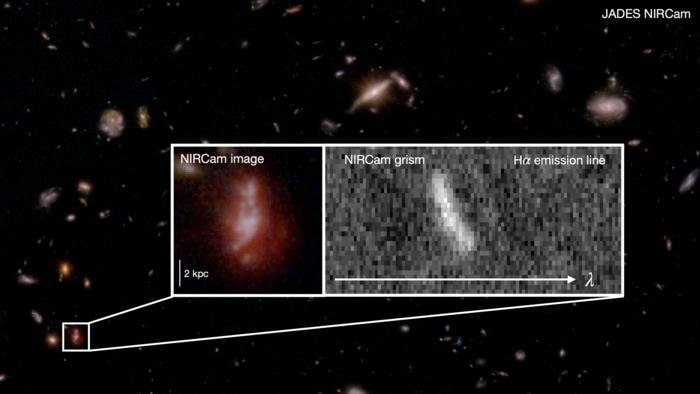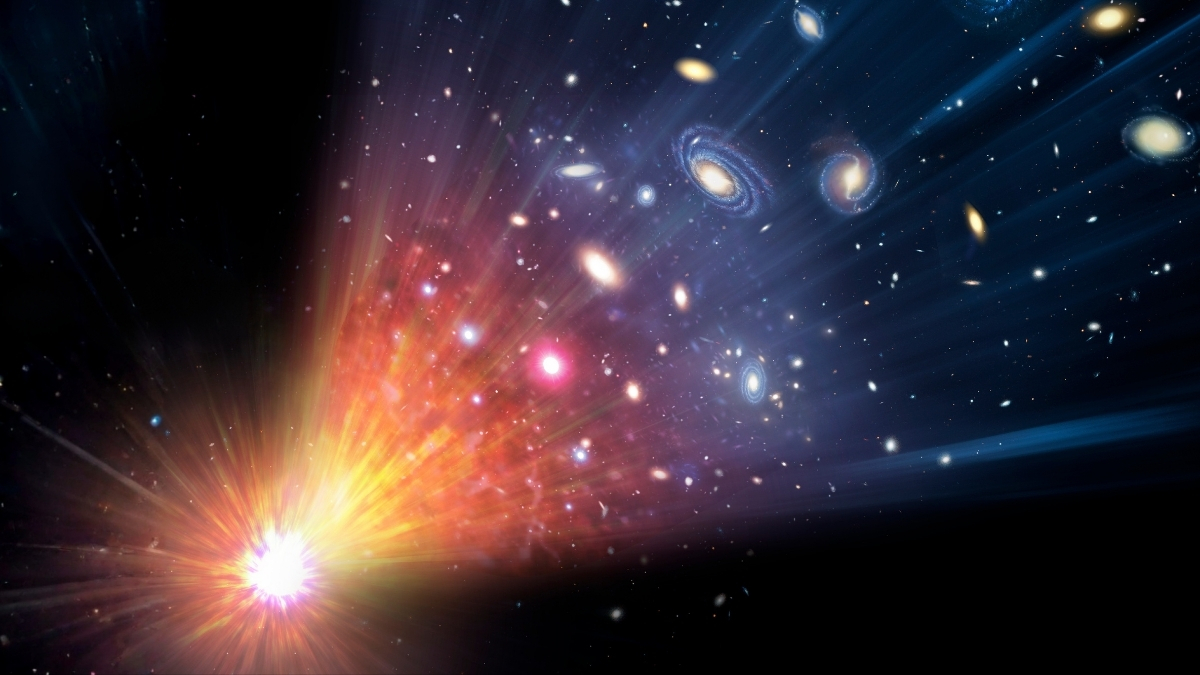The universe’s first galaxies were hot messes, according to a recent study. During their younger days, they were wild, chaotic bundles of turbulent gas, churned up by huge gulps of intergalactic gas, bursts of massive star formation, and raging supermassive black holes.
The team of astronomers suggesting this idea, led by Cambridge University’s Lola Dunhaive, recently pointed the James Webb Space Telescope (JWST) at 272 small galaxies, dating back to between 800 million and 1.5 billion years after the Big Bang. The universe was still very young (in astronomical terms) when the light from these galaxies began its journey to our corner of the cosmos; now that this light has arrived to the JWST’s eye, scientists saw the faraway galaxies looking dramatically different from the mature, sedately rotating disks we see in the nearby universe.
Dunhaive and her colleagues used the JWST’s NIRCam instrument to watch how ionized hydrogen gas moved around in each galaxy. In most of the subjects, instead of circling the galaxy’s center in a single smooth current, gas was flowing in all directions, creating turbulent eddies, shock waves and uneven clumps of matter.
The galaxies we can see in the nearby universe are more modern, and most of them are neatly structured disks and spirals, where all the gas and stars move in the same direction around the center — unless they’ve suffered a recent collision or near-miss with another galaxy, anyway. But the farther astronomers peer back in time, the messier things get.
Even galaxies have a messy era
Dunhaive and her colleagues describe the galaxies in their study as existing at “the dawn of disks, where galaxies start to be sustained by rotation but will go through several episodes of instability … before settling into the cold disks we observe in the local universe.” (Same, galaxies. Same.)
The JWST showed Dunhaive and her colleagues how their sample of distant galaxies looked when the universe was between 800 million and 1.5 billion years old. That’s near the end of the period known as Cosmic Dawn (50 million to 1 billion years after the Big Bang), when the first stars and galaxies formed — and just on the brink of the period known as Cosmic Noon (2 to 3 billion years after the Big Bang), when bursts of new stars were lighting up the universe at a higher rate than at any time before or since. The messy little galaxies in Dunhaive and her colleagues’ study were ramping up their star formation to the dramatic fireworks of cosmic noon, and that’s part of why things in those galaxies were so turbulent.
Newborn stars, like newborn humans, are prone to tantrums. For a star, that means scouring the surrounding space with powerful stellar winds of charged particles, along with blasts of high-energy radiation, especially in the ultraviolet wavelengths. That makes the space in stellar nurseries (huge clouds of cold gas where new stars are forming) turbulent and chaotic. Adding to the chaos, models and observations tell us that in those early galaxies, star formation tended to happen in irregular, dramatic bursts.
These galaxies were also flailing their way through adolescence at a time when the clouds of gas suffusing the universe were much denser than they are today. After all, the universe has been inflating since the Big Bang, so it was technically a much smaller place just before Cosmic Noon – but with the same amount of matter. That fact had a huge impact on the young galaxies, because it meant that intergalactic gas was flowing — and sometimes rushing — into the young galaxies, stirring up turbulence in the process. And the supermassive black holes at the heart of each galaxy were ravenously feasting on all that gas and belching out relativistic jets of matter and radiation.
And most of the galaxies in Dunhaive and her colleagues’ study were tiny compared to the ones in our nearby universe: between 100 million and 10 billion times the mass of our sun (our Milky Way weighs in at about 1.5 trillion solar masses).
That means that things like supermassive black holes, incoming rivers of gas and bursts of star formation had an outsized impact on their stability. In other words, it was a weird time, and these young galaxies just had a lot going on.
What’s next?
The astronomers noticed a few exceptions: early galaxies that, for some reason buried in the stochastic processes of their pasts, managed to pull themselves together a little earlier than their peers. Those galaxies tended to be larger than average, which probably made them more resilient in the face of cosmic disruption. But most galaxies in the study were clearly still going through their messy phase.
A few previous studies have spotted some of those precocious galactic outliers, but astronomers couldn’t be sure whether they were normal. Models and simulations suggested that they shouldn’t be; instead, early galaxies were predicted to be turbulent, clumpy messes. Now, astronomers know the messy reality of early galaxies seems to line up well with physicists’ mathematical models of how the universe works.
For Dunhaive and her colleagues, the next step will be to combine their recent observations of hot, ionized hydrogen gas with upcoming observations of cold gas and dust in the same distant, early galaxies. That will reveal more about the galaxies’ structure and evolution.
“With more data, we’ll be able to track how these turbulent systems grew up and became the graceful spirals we see today,” said Tacchella.
The team published the new findings on Oct. 22 in the journal Monthly Notices of the Royal Astronomical Society.
Source link


:max_bytes(150000):strip_icc()/ar-foik-hot-chocolate-mix-ar-adobe-2x1-046dd5ba64e54f31aaeec5357f24ca2e.jpg)